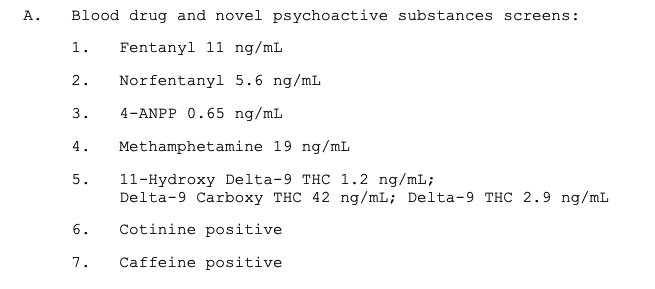Autopsies
Two sets of autopsy results publicized on June 1, 2020, determined that Floyd's death was a homicide.[93][94] The conclusions, one by a local government official and one by doctors working for Floyd's family, differed over whether there were contributing factors, and whether the agreed cause, restraint and neck compression, was combined with subdual or asphyxiation.[94]
Andrew Baker, a pathologist and the chief medical examiner for Hennepin County since 2004, performed an autopsy examination at 9:25 a.m. on May 26.[95][96] Prosecutors who were filing charges against Chauvin summarized portions of preliminary findings in court documents that were released publicly on May 29.[97] His final autopsy findings,[98][95] issued June 1,[99] found that Floyd's heart stopped while he was being restrained and that his death was a homicide caused by "cardiopulmonary arrest complicating law enforcement subdual, restraint, and neck compression".[100]
Fentanyl intoxication and recent methamphetamine use may have increased the likelihood of death.[101][102] Other significant conditions were arteriosclerotic heart disease and hypertensive heart disease, including an enlarged heart, one artery 90% blocked, and two others 75% narrowed.[103][98][104] The report states that on April 3 Floyd had tested positive for SARS-CoV-2, the virus that causes COVID-19, but does not list it as a fatal or other significant condition.[105][106]
Attorneys for Floyd's family announced on May 29 that they would commission a second autopsy.[107] It was carried out on May 31 by Michael Baden, a pathologist and former New York City chief medical examiner, and by Allecia Wilson, a pathologist and director of autopsy and forensic services at the University of Michigan Medical School.[108][109] They announced their results on June 1, a few hours before Baker's final findings were issued.[110] From the evidence available to them, which did not include a toxicology report or unspecified bodily samples, they found that Floyd's death was a homicide caused by asphyxia due to neck and back compression.[111][108][103] Also, Floyd had no underlying medical problem that contributed to his death.[112] They said neck compression affected blood flow to the brain,[103] being able to speak does not mean that someone is able to breathe[112] and Floyd apparently died at the scene.[110]
It was revealed in August 2020 that the United States Department of Justice had the Office of the Armed Forces Medical Examiner review the state's official autopsy results, with the review agreeing with the Hennepin County Medical Examiner's findings, including that the death was a homicide. The Office of the Armed Forces Medical Examiner added that the police "subdual and restraint had elements of positional and mechanical asphyxiation".





 Rispondi Citando
Rispondi Citando


